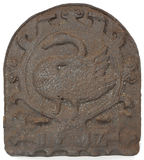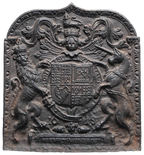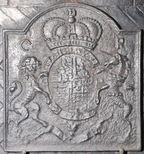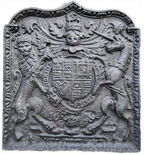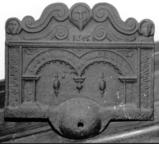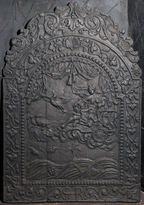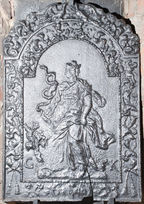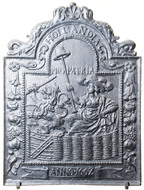-
889
Description: Arched shape; fillet edging; swan within a voided strapwork cartouche; date in Arabic numerals, at bottom, on a broad horizontal fillet.
Notes: Stylistically, of the early 17th century, suggesting the date is 1617, although the third numeral is indistinct. Bonham's sale, Chester, 18 October 2012, lot 384 (£375).
Inscription: 16 1[?]7
- Decoration tags:
- rounded arched (shape)
- fillet (edging)
- whole carved pattern
- heraldic
- architectural
- text
- animals
Manufactured: in 1617 in England.
Current location: not known.
- Attached to series:
- Miscellaneous pattern firebacks
-
880
Description: Rectangular with ogee arch; ovolo, egg and dart edging; shield, garter, helm, mantling, crest and motto of the English House of Stuart; date split either side of garter buckle.
Notes: One of several firebacks, all of the same date, but varying in size, framing style and moulding; all have stylistic features in common and will have been the work of the same pattern maker, who was also responsible for carving royal coats of arms in three West Country churches. Similar in design but proportionately different to no. 1062. Christie's auction 19 Jun 2012 lot 191 (£1,750).
Copies of this fireback are known.
Inscription: HONI SOIT QVI MAL Y PENSE / 16 18 / DIEV ET MON DROIT
Arms: English Stuart royal (James I)
- Decoration tags:
- rectangular with ogee-arch (shape)
- ovolo, egg and dart (edging)
- whole carved pattern
- armorial
- text
Manufactured: in 1618 possibly in the Forest of Dean area of England.
Current location: not known.
-
282
Description: Arched rectangle; cavetto moulded edging; garter enclosing Stuart royal arms, crown, crowned lion and unicorn supporters and motto; initials in top corners.
Notes: The crown is not typically English in form, suggesting that the patternmaker may have been of foreign extraction.
Copies of this fireback are known.
Inscription: C R / [Garter motto - illeg.]
Arms: English Stuart royal
- Decoration tags:
- rectangular with round arch (shape)
- cavetto (edging)
- whole carved pattern
- armorial
- royal
- text
Manufactured: in the mid- to late-17th century in England.
Current location: Chequers, Ellesborough, Buckinghamshire, England.
-
1062
Description: Rectangular with ogee arch; ovolo, egg and dart edging; shield, garter, helm, mantling, crest and motto of the English House of Stuart; date split either side of garter buckle.
Notes: One of several firebacks, all of the same date, but varying in size, framing style and moulding; all have stylistic features in common and will have been the work of the same pattern maker, who was also responsible for carving royal coats of arms in three West Country churches. Similar in design but proportionately different to no. 880.
Copies of this fireback are known.
Inscription: HONI SOIT QVI MAL Y PENSE / 16 18
Arms: English Stuart royal (James I)
- Decoration tags:
- rectangular with ogee-arch (shape)
- ovolo, egg and dart (edging)
- whole carved pattern
- heraldic
- armorial
- text
Manufactured: in 1618 possibly in the Forest of Dean area of England.
Current location: not known.
-
123
Description: Rectangular; top panel with bearded face between symmetrical horizontal scrolls, and faces at either end; scrolls are repeated below, on either side of the date, all above a horizontal double fillet; below, a pair of arches with guilloche decoration between fillets, and toothed on the underside, are supported on each side by Tuscan columns, also with guilloche decoration; this is repeated in symmetrical rectangular panels on either side; at the centre base a bulbous nozzle protrudes.
Notes: This is a smith's forge fireback, the nozzle being the tuyere directing the air into the fire from bellows behind. Stylistically similar to the Lenard and other firebacks of the same period, the carved elements above the nozzle may have been cast from a pattern inspired by the back of a joined 'wainscot' chair, with the date inserted. The back may have been used for forging non-ferrous metals as there was a trade in pot-founding in bronze as well as iron at some ironworks in the Weald. Formerly part of the Ade Collection (from Grove Hill, Hellingly, Sussex).
Inscription: 1655
- Decoration tags:
- rectangular with round arch (shape)
- fillet (edging)
- whole carved pattern
- individual numbers
- architectural
- text
- humans
Manufactured: in 1655 in the Weald area of England.
Current location: Hastings Museum and Art Gallery, John's Place, Bohemia Road, Hastings, East Sussex, England.
Museum number: HASMG: 1952.51.62 (part of the Hastings Museum museum group)
Citation: Butterfield, W. R., 1916, 'Old Wealden Firebacks', The Connoisseur, 46, pp. 197-209.
- Attached to series:
- Chair pattern firebacks
- Furniture stamp firebacks
-
327
Description: Arched rectangular shaped central panel with open-bud edging; pictorial: Venus in her chariot drawn by doves, with her child, Cupid; a heron flies away to the left; above are swagged curtains and a pair of tassels, below is a landscape; arched rectangular shaped border with fillet edging, a scallop shell top centre with symmetrical arrangement of vine and acanthus leaves and tendrils; the monogram, SHR, bottom centre; above is a symmetrical design of scrolled floral tendrils.
Notes: The design is derived from a personification of the planet Venus in 'Planetarum effectus et eorum in signis zodiaci', by Marten de Vos (1585). Two editions of engravings of de Vos's drawings are known, by Jan Sadeler, dated 1585, and by Gregor Fentzel in about 1650. The flying heron has been copied from a print by Wenceslaus Hollar c.1658. The theft, in 1699, from a Thames-side warehouse of several firebacks, included '6 of Venus in a Chariot with Doves', which is likely to refer to this type (Post Boy 11-14 Nov. 1699).
Copies of this fireback are known.
Inscription: SHR
- Decoration tags:
- 'Dutch' (shape)
- fillet (edging)
- whole carved pattern
- planklines
- pictorial
- mythological
- allegorical
- text
- animals
- humans
Manufactured: in the late-17th century in England.
Current location: Horsham Museum, Causeway, Horsham, West Sussex, England.
(part of the Horsham Museum museum group)
- Attached to series:
- SHR series
- British 'Dutch' style firebacks
- De Vos Planets series
-
344
Description: Arched rectangular central panel, with bead-and-pellet edging; pictorial, standing female figure in classical dress, facing to the left, holding a snake in her right hand, a bunch of flowers at lower left; the initials located in bottom corners; arched rectangular border, fillet edging, containing swirled foliage, with a putto in the top corners; on top, two perched bird facing each other, with swirled foliage descending behind them.
Notes: The figure is of Sapientia, or Wisdom, based closely on an engraving, one of a set entitled 'The Virtues' by Hendrik Goltzius c.1593; a small number of firebacks bear the initials, GK; it is not known to whom they refer, but dated ones are of 1700.
Copies of this fireback are known.
Inscription: G K
- Decoration tags:
- 'Dutch' (shape)
- fillet (edging)
- whole carved pattern
- pictorial
- allegorical
- text
- humans
Manufactured: in the early-18th century in the Siegerland area of Germany.
Current location: Ightham Mote, Ightham, Kent, England.
Museum number: 825381 (part of the National Trust museum group)
- Attached to series:
- 'Dutch' GK series
-
425
Description: Arched rectangular central panel with bead-and-pellet edging; S-scroll, two-handled, gadrooned vase with tulip stems, flowers and leaves; arched rectangular border with fillet edging and suspended flower bunches; two symmetrical, coiled serpents on top; narrow, curved shouldered side panels with beads in oval depressions.
Notes: This is a shortened version of a much-copied fireback. Normally there is a bottom panel. Formerly part of the J. H. Every collection.
Copies of this fireback are known.
- Decoration tags:
- 'Dutch' (shape)
- fillet (edging)
- whole carved pattern
- extension panels
- plants
- objects
Manufactured: in the late-17th century in England.
Current location: Anne of Cleves House, Southover High Street, Lewes, East Sussex, England.
Museum number: 1944.24.091 (part of the Sussex Archaeological Society museum group)
- Attached to series:
- Flower Vase 'Dutch' types
- British 'Dutch' style firebacks
-
1237
Description: Low-arched rectangular shape; cavetto-moulded edging (top and sides); top centre, shield, crest and motto of William Wood (1806-88), Bishop of Glasgow and Galloway.
Notes: The blazon: Per chevron Argent and Or, a chevron counter-embattled between three mullets gules; crest: a talbot's head erased Or; motto: Semper Vigilans - Always Vigilant.
Inscription: SEMPER VIGILANS
Arms: William Wilson, Bishop of Glasgow and Galloway
- Decoration tags:
- rectangular with round arch (shape)
- cavetto (edging)
- whole carved pattern
- heraldic
- armorial
- text
Manufactured: in the mid- to late-19th century in Scotland.
Current location: Norfolk Antique and Reclamation Centre, Woolseys Farm, Salhouse Road, Panxworth, Norfolk, England.
- Attached to series:
- Personal armorial firebacks
-
566
Description: Arched rectangular central panel; bead-on-fillet edging; wickerwork Garden of Holland (Hollandse Tuin) within which is seated a berobed female figure holding a cap of freedom on the end of a long pole; before her is the crowned heraldic lion of the States General of the Netherlands, clutching a sheaf of arrows in its left front paw; above are the words, Pro Patria; arched rectangular border with cavetto-moulded edging, with the word, Hollandia, in the arch, suspended from which are festoons of flowers and fruit and the date within a scroll on the bottom; on top, a scallop shell between two mirrored serpents.
Notes: An overtly patriotic theme with symbols of Dutch nationhood. Mitford collection, Petworth House.
Copies of this fireback are known.
Inscription: HOLLANDIA / PRO PATRIA / ANNO 1662
- Decoration tags:
- 'Dutch' (shape)
- cavetto (edging)
- whole carved pattern
- heraldic
- pictorial
- allegorical
- text
- humans
Manufactured: in 1662 in the Siegerland area of Germany.
Current location: Petworth House, Petworth, West Sussex, England.
Museum number: NT/PET/M/59 (part of the National Trust museum group)
- Attached to series:
- 'Dutch' Garden of Holland firebacks
